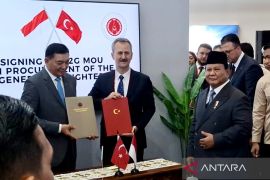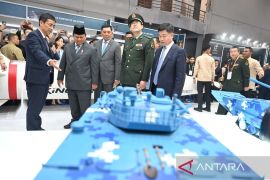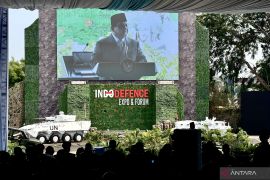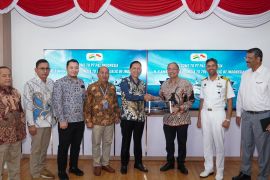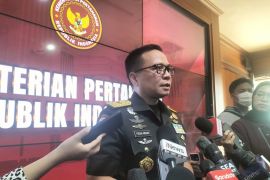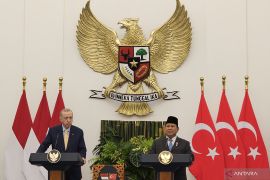Indonesia's interest in ANKA started when the Defense Ministry floated a tender for UAV procurement on June 28, 2018, to strengthen the combat readiness of the Indonesia Defense Forces (TNI). ANKA’s developer, Turkish Aerospace, participated in the tender, offering ANKA to Indonesia on August 24 the same year.
Within less than three months, Turkish Aerospace came to Indonesia to introduce ANKA at the Indo Defense Expo & Forum in Jakarta, which was held on November 7–10, 2018. A replica of ANKA, in its original size (full mock-up), was exhibited during the four-day exhibition in Jakarta.
However, the UAV procurement was delayed due to the presidential election in 2019. After his re-election, President Joko Widodo (Jokowi) appointed his competitor in the presidential election, Prabowo Subianto, as Defense Minister.
Under Subianto's leadership, the UAV procurement was back on track. After taking over office, the minister paid a visit to Turkey twice — in November 2019 and July 2020 — to discuss cooperation in the manufacturing of drones and tanks with head of the Turkish Defense Industry Agency (SSB), Professor Ismail Demir. Subianto also visited several Turkish defense industries, including Turkish Aerospace.
As a follow-up to that meeting, Turkish Aerospace and state-owned aircraft manufacturer PT Dirgantara Indonesia (PT DI) signed a framework agreement under the Aerospace Engineering program at the opening ceremony of the Indo Defense Expo & Forum in Jakarta on November 2, 2022.
At the signing ceremony, Turkish Aerospace was represented by its president & CEO, Temel Kotil, while PT Dirgantara Indonesia was represented by its director, Gita Amperiawan. The signing was witnessed by Minister Subianto and Professor Demir.
The Indonesian Defense Ministry and Turkish Aerospace held another meeting in Jakarta on February 3, 2023, to sign a cooperation agreement for the purchase of 12 ANKA units, which would include several training programs, technology transfer, support for integrated logistics support (ILS), ground support and test equipment (GS&TE), flight simulator, and hangar infrastructure with a warranty period of 24 months/600 flying hours.
When contacted at the end of July 2023, head of the public relations bureau of the Secretariat General of the Ministry of Defense, Brigadier General Edwin Adrian Sumantha, informed that the contract for the purchase of 12 ANKA units was worth US$300 million, or equivalent to Rp4.5 trillion.
According to the Ministry of Defense, the contract is currently in the process of being activated at the Ministry of Finance.
It is planned that ANKA will be sent to Indonesia within 32 months after the contract becomes effective.
Technology transfer
Under the ANKA purchase contract, Turkish Aerospace has agreed to support the transfer of technology through the assembly of 6 ANKA units by PT Dirgantara Indonesia in Bandung, West Java.
"For the purchase contract with Indonesia, 6 units will be assembled in Turkey, and the other 6 units will be assembled at PT DI. This is a form of technology transfer. We plan to start sending the components in August this year," Turkish Aerospace president and CEO Kotil told ANTARA during a special interview in Istanbul, Turkey, on July 27, 2023.
ANTARA had the opportunity to join the special interview session with Kotil along with 7 other media agencies from Indonesia and Malaysia on the sidelines of the 2023 International Defense Industry Fair (IDEF) at the Tüyap Fair Convention and Congress Center in Istanbul.
ANKA, which is a medium altitude long endurance (MALE) UAV, is capable of performing several functions as a combat drone, including observation (intelligence, surveillance, and reconnaissance/ISR), target detection and identification, signal intelligence and electronic warfare, close air support mission, monitoring of maritime and border areas, communication relay, and air-to-ground strike, and it can be equipped with several types of weapons.
According to Kotil, ANKA can fly for up to 30 hours and reach an altitude of 30 thousand feet, with the line of sight (LOS) range reaching more than 250 kilometers. ANKA can also carry payloads of up to 350 kilograms.
The configuration of devices and weapons that can be installed on ANKA including EO/IR SATCOM+Radio Relay, EO/IR+SATCOM+Laser Guided Smart Bombs and Missiles, EO/IR+SATCOM+SAR/ISAR/GMTI+AIS, and EO/ IR+COMINT/DF+ESM/ELINT.
The Turkish-made combat drone has a wing span of 17.5 meters and measures 8.6 meters in length and 3.25 meters in height.
Until now, Turkish Aerospace has sent 36 ANKA units to the Turkish Air Force, Turkish Navy, Turkish Interior Ministry, Turkish Directorate General of Forestry, and also to several countries such as Tunisia and Chad. Besides Indonesia, other countries that have bought ANKA are Kazakhstan, Malaysia, Kyrgyzstan, and Angola.
It is planned that the 12 ANKA units purchased by Indonesia will later be used by the Indonesian Air Force (6 units), the Indonesian Navy (3 units), and the Indonesian Army (3 units).
Seizing an opportunity
The success of the Turkish defense industry in producing its own combat drone is certainly a big achievement considering that only a few countries have the capability to make their own combat drones, namely the United States, which produced its combat drone in 2001, the United Arab Emirates (UAE) in 2002, Israel in 2004, the United Kingdom in 2005, and then Italy, Greece, Sweden, Switzerland, Spain, and France jointly developed one in 2006.
From 2010 onwards, Iran, South Africa, Turkey, North Korea, Pakistan, Russia, Taiwan, Jordan, South Korea, Germany, Georgia, Japan, India, Ukraine, Australia, Saudi Arabia, and Belarus have tried to produce drones domestically. Indonesia unveiled the prototype of its domestic UAV called the Black Eagle in 2019.
Research on the development of the Black Eagle was carried out in 2015 and involved a consortium of the Defense Ministry, PT Dirgantara Indonesia, TNI, Bandung Institute of Technology (ITB), and the Agency for the Assessment and Application of Technology (BPPT) and National Aeronautics and Space Institute (LAPAN) that merged into the National Research and Innovation Agency (BRIN).
However, during a joint meeting with the Indonesian House of Representatives (DPR RI) in September 2022, BRIN head Laksana Tri Handoko informed that the drone's intended use was being shifted from catering to military needs to civilian needs. This was based on the results of an evaluation conducted from July to December 2021, including the results of an unsuccessful Black Eagle test flight in Pangandaran.
"We have two problems, namely technical problems and problems of technology ownership," he informed.
Regarding technical issues, Handoko said that adequate testing of each aircraft component, in accordance with the established stages and standards, had not been carried out. In fact, this stage should have been carried out prior to the first test flight.
On the technology ownership issue, he informed that all of Black Eagle's key technologies have come from abroad, especially the mission system, except the platform.
"The technology used for this mission system comes from a company in Spain," he said.
Reflecting on this experience, the cooperation to domestically assemble 6 ANKA units needs to be utilized by the Indonesian defense industry, especially PT Dirgantara Indonesia.
A UAV cannot be developed quickly, especially if the infrastructure and other supporting components are inadequate. The Turkish defense industry, including Turkish Aerospace, took a long time to develop its own combat drone technology.
Currently, Turkish Aerospace has aircraft, fighter aircraft, aerospace technology, and satellite manufacturing and assembly facilities in Kahramankazan, Ankara, Turkey, which cover an area of 700 thousand square meters. The company employs more than 6 thousand technicians and experts.
However, all of this has been the result of consistency, ambition, cooperation, and support from various parties, especially the Turkish government, in the past five decades.
Indonesia actually has the potential to create a defense industry with a capacity similar to Turkey. However, it can only be realized through consistent and concrete support, especially in terms of financing for the domestic defense industry.
Related news: Ministry facilitates drone industry to showcase products in Singapore
Related news: Govt launches apps to ease drone, aircraft operation
Related news: Indonesia, Turkey discuss defense cooperation
Translator: Genta Tenri M, Resinta S
Editor: Sri Haryati
Copyright © ANTARA 2023

